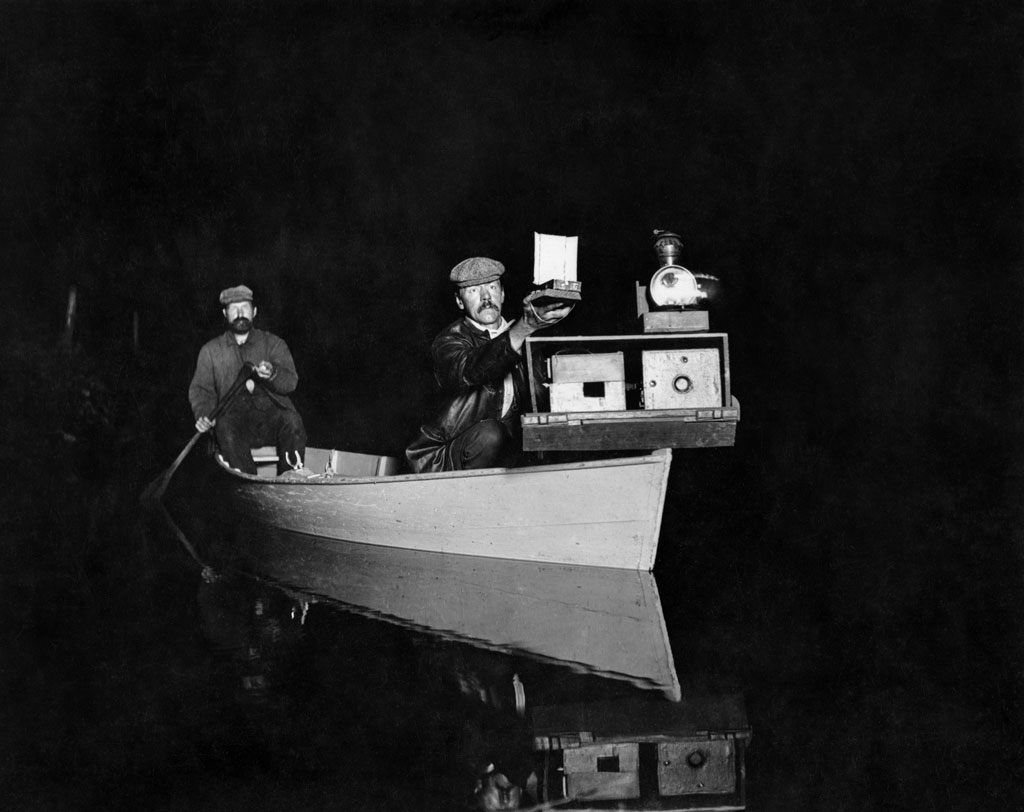Encyclopedia Dubuque
"Encyclopedia Dubuque is the online authority for all things Dubuque, written by the people who know the city best.”
Marshall Cohen—researcher and producer, CNN
Affiliated with the Local History Network of the State Historical Society of Iowa, and the Iowa Museum Association.
SHIRAS, George III
Family History: http://wc.rootsweb.ancestry.com/cgi-bin/igm.cgi?op=GET&db=ja1506&id=I37518

SHIRAS, George III. (Allegheny, PA, Jan. 1, 1859--Marquette, MI, Mar. 24, 1942) To many wildlife photographers, Shiras is affectionately known as "Grandfather Flash." The son of George SHIRAS, Jr. and nephew of the legendary Oliver Perry SHIRAS, this pioneering photographer compiled the following record of achievements: (1)
(1) the first to photograph in daylight wild animals and
birds from a canoe or blind;
(2) the first to get automatic daylight pictures of wild
animals by their touching a string across a trail or
pulling on bait attached to a string operating the
shutter of a camera;
(3) the first to operate the camera at a distance by a
string running from a blind;
(4) the first to invent a method for picturing animals from
a canoe by hand flashlight;
(5) the first to invent a method to obtain automatic flash-
light photographs in which the animals or birds fired
the flash;
(6) the first to use two flashlights and two cameras, one
set picturing the animal when resting and the other set,
a second later, showing the animal in action when alarmed
by the explosion of the first flashlight; and
7) the first to practice wing shooting with the camera on an
apparatus allowing wild fowl and shore birds to be
photographed when flying from 50 to 70 miles an hour.
Photography, it must be remembered, was an interest of a man whose father was a U.S. Supreme Court justice. George Shiras, 3rd, as he wrote his name, had a promising legal career of his own. He even served a term in the U.S. Congress, where he introduced legislation that became the Migratory Bird Law-securing for Shiras an important place in the conservation movement. Shiras married his wife, daughter of Peter White, noted pioneer and prominent citizen of Marquette, Michigan and had two children, a boy and a girl. By the age of thirty, he gave up hunting and fishing for the desire to study his former quarry.
When Shiras and his family established their retreat on Whitefish Lake (now known as Peter White Lake) near Deerton, Michigan, wildlife photography barely existed. He developed his methods slowly. He began floating quietly in a canoe after dark taking a shot towards the source of a sound. He later rode in a canoe with a bright light shining in the front. The bright light captured the eye shine of animals--a trick he learned from the Ojibwe. (2) He also set up bait attached to trip wires where the animal taking the bait took its own picture.
The famous "Midnight Series" of deer at night, was photographed entirely around Deerton. In 1900 it won the gold medal in the Forestry Division at the Paris Exposition and top prize in the photographic division without being formally entered in that competition. In 1904 the series received the grand prize at the St. Louis World's Fair. (3)
Shiras came to the attention of Gilbert H. Grosvenor, the editor of the National Geographic. The July 1906 issue of the magazine published 74 of Shiras's photographs accompanied by only a brief text. The devotion of nearly the entire issue to George 3d, was unheard of in its day. Everyone, however, was not pleased. Two board members of the Society resigned claiming the Geographic was becoming a "picture book." (4) For Shiras, it meant wide publicity of his pioneering work. President Theodore Roosevelt asked Shiras to
write a big book-a book of bulk as well as worth,
in which you shall embody these pictures and the
results of all your invaluable notes upon the habits,
not only of game but of the numerous other wild
creatures that you have observed....Do go ahead and
do this work! (5)
Although impressed with this appeal, Shiras was too busy with his own pursuits of photography and conservation. He discovered a moose subspecies in Yellowstone National Park. (6) He led efforts that resulted in the creation of Olympia National Park and Petrified Forest National Park and an extension of Yellowstone. (7) Between 1906 and 1932 Shiras published nine illustrated articles for the National Geographic. Pictorial supplements of two of his prizewinning photographs of deer at night were included with the July 1913 and August 1921 issues.
A National Geographic Society trustee since 1911, Shiras in 1928 donated 2,400 of his finest glass plate photographs to the Society for permanent retention in its files. He selected 950 of these images for a two-volume work of extensively revised versions of his many articles. Hunting Wild Game with Camera and Flashlight was published in 1935. The first volume, almost entirely devoted to the images captured at Whitefish Lake and the Upper Peninsula, was dedicated to Theodore Roosevelt who had originally encouraged the work. The prestigious British Journal of Nature proclaimed the book "an outstanding work of its kind" that "must be looked upon as a classic in the history of wildlife photography." Unfortunately Shiras discovered minor errors in the text. The necessary corrections led to the second edition of the work, amended, revised, and enlarged, which was published in 1936. Shiras died while in the process of making further revisions. (8)
---
Source:
1. Classen, Mikel B. George Shiras 3D - The First True Wildlife Photographer. Online: http://www.mikelclassen.com/George_Shiras_III.php
2. Meier, Allison. "The First Flash Photographs of the Natural World at Night," Hyperallergic, Online: https://hyperallergic.com/270663/the-first-flash-photographs-of-the-natural-world-at-night/
3. Classen
4. Frank, Priscilla. "How A Nocturnal Politician Became The Unlikely Father Of Wildlife Photography," Huffpost. Online: https://www.huffingtonpost.com/entry/george-shiras-wildlife-photography_us_56afb06de4b0b8d7c2301a07
5. Classen.
6. Frank
7. Meier
8. Classen

